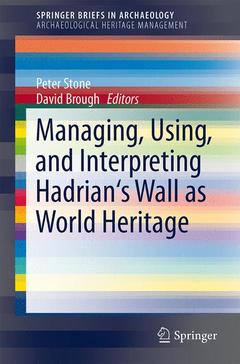Managing, Using, and Interpreting Hadrian's Wall as World Heritage, 2014 SpringerBriefs in Archaeological Heritage Management Series
Coordonnateurs : Stone Peter G., Brough David

Peter Stone is Head of School of Arts and Cultures and Professor of Heritage Studies in the International Centre for Cultural and Heritage Studies at Newcastle University. He was a member of the Hadrian’s Wall World Heritage Site Management Plan Committee between 1998 and 2012 and Chair of the Committee between 2005 and 2012. He has published widely on heritage management, interpretation and education and has worked extensively overseas. In the mid 1990s he helped UNESCO develop the World Heritage Education Programme and draft the World Heritage in Young Hands kit. He was a member of the National Trust’s Archaeology Advisory Panel between 2005 and 2012. In 2004 he worked with the North East Regional Development Agency regarding the economic value of World Heritage Sites. He is currently working with the Xi’an Municipal Administration of Cultural Heritage and the Institute of Archaeology of the Chinese Academy of Social Sciences on heritage management issues in China. Before joiningNewcastle University in 1997 Peter worked for ten years for the English Heritage Education Service during which time he was seconded for a year to be Regional Administrator for the South West, where he was responsible for the day-to-day management of 104 properties including Stonehenge and Avebury.
David Brough is a former Development Manager with Hadrian’s Wall Heritage Ltd, who now works as an independent heritage management consultant. He acted as Joint Editor of the Hadrian’s Wall Management Plan 2008-14, and then as acting Management Plan Co-ordinator was responsible for the development of the Interest Groups to coordinate the implementation of the Plan. David has also provided advice to the Frontiers of the Roman Empire Management Group on the preparation of the Site’s retrospective Statement of Outstanding Universal Value and the compilation of its Periodic Report. In parallel with this he completed an MLitt research degree which investigated the concept of serial World H
Date de parution : 11-2013
Ouvrage de 139 p.
15.5x23.5 cm



